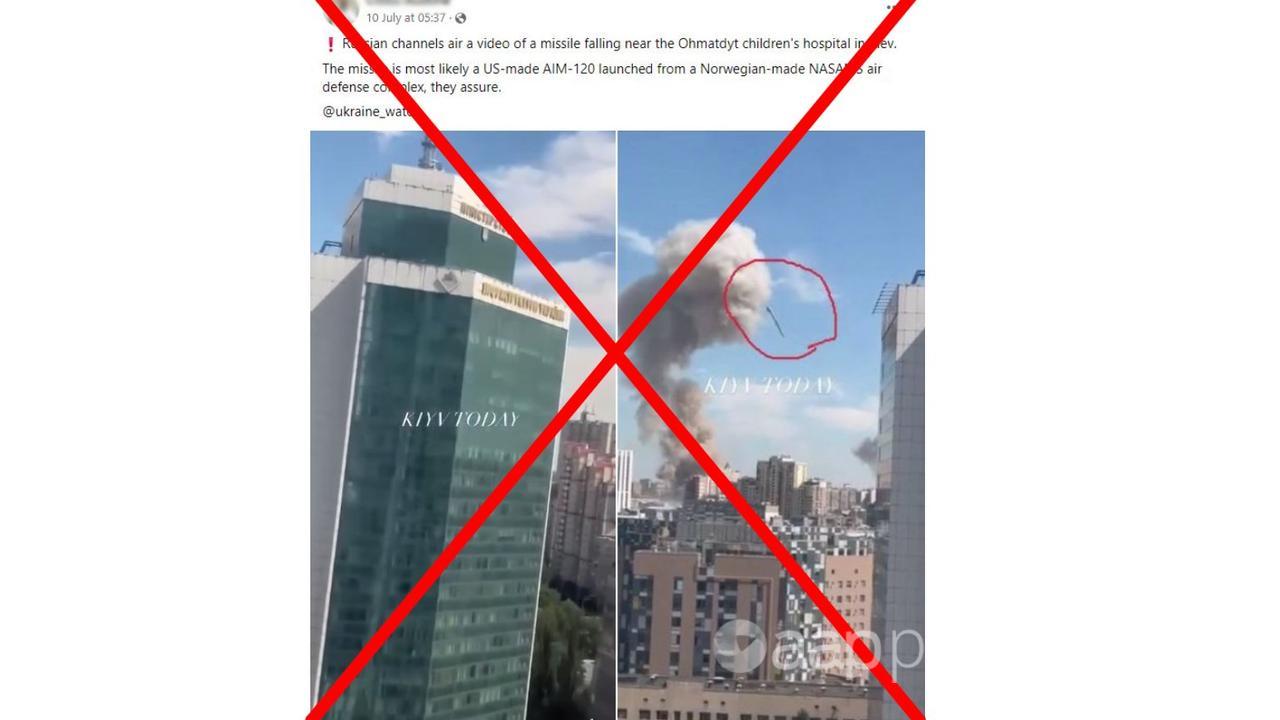AAP FACTCHECK – A missile which struck a children’s hospital in Kyiv was a US-supplied, Ukrainian warhead, social media accounts have claimed.
This is false. Experts who have analysed images of the missile say it was almost certainly a Russian Kh-101 warhead, not the Ukrainian AIM-120 as claimed in many posts.
Experts say the US-supplied AIM-120 couldn’t have caused the scale of destruction witnessed at the hospital, while the Russian Kh-101 is capable of such damage.
The Ohmatdyt Children’s Hospital was hit in a missile attack on July 8, The Security Service of Ukraine said a Russian Kh-101 warhead hit the facility.
However, social media users, including many known pro-Kremlin accounts, have pointed to a video of the strike and said the warhead responsible was the US-supplied AIM-120.
Experts told AAP FactCheck the missile in the video is clearly the Russian Kh-101.

Fabian Hoffmann, a research fellow at the University of Oslo who specialises in missile technology, points AAP FactCheck to a debunk he posted on X, formerly Twitter.
He says the shape and features of the pictured missile “conclusively” prove it was the Russian Kh-101.
In particular, he says the pictured missile has a “bottom-mounted turbofan”, typical of Russian land-attack cruise missiles such as the Kh-101, which he says is now considered outdated.
He also points to the two “relatively large wings” which are consistent with the Russian warhead, but not the AIM-120.
He says the rear fins are also too large and don’t match the shape of the AIM-120, while the missile’s “blunted nose” is inconsistent with the AIM-120’s “conic and pointy” nose.
He points his X followers to the “atmospheric distortions” which indicate the exhaust stream coming from the missile.
“This is typical for cruise missiles like the Kh-101, as cruise missiles are continuously propelled until impact.
“In contrast, rocket-propelled missiles like the AIM-120 burn their fuel within seconds and then glide to their target, so you wouldn’t see an exhaust stream this late in the flight.”
Markus Schiller, an associate senior researcher at the Stockholm International Peace Research Institute, agreed, telling AAP FactCheck the missile in the video is “definitely not” the AIM-120.
“The proportions between diameter, length, fin sizes at the back, gondola size, and wing sizes also looks very much like a cruise missile, and pretty much like the Kh-101,” he says.
“An AIM-120 looks very different, though. It has four short fins in the middle instead of two wings.”
Both Dr Schiller and Mr Hoffmann also say the AIM-120 couldn’t have caused the damage documented at the hospital.
Dr Schiller says the AIM-120 carried less than 10kg of explosives and is primarily designed to take down unarmoured aircraft through the spread of shrapnel.
In comparison, he says the Kh-101 can carry around 250kg of explosives and is designed to take out hardened targets and buildings.
Mr Hoffman agrees, saying the AIM-120 couldn’t create the damage observed at the hospital.
“In contrast, a ~400 kg Kh-101 warhead with approximately 200 kg of explosives absolutely can,” he says.
Investigative outlet Bellingcat also examined the claim and came to the same conclusion after comparing images of the missile to a 3D model of the AIM-120.
The organisation geolocated images from the aftermath of the attack to the wreckage of the hospital, and identified components of the Russian rocket including the engine panel and a support spar that match the Kh-101.
The Verdict
False – The claim is inaccurate.
AAP FactCheck is an accredited member of the International Fact-Checking Network. To keep up with our latest fact checks, follow us on Facebook, Twitter and Instagram.
All information, text and images included on the AAP Websites is for personal use only and may not be re-written, copied, re-sold or re-distributed, framed, linked, shared onto social media or otherwise used whether for compensation of any kind or not, unless you have the prior written permission of AAP. For more information, please refer to our standard terms and conditions.


















